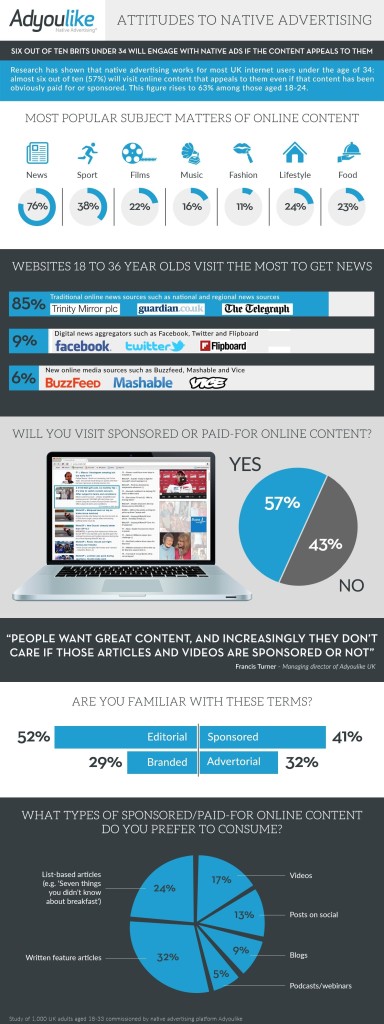Research unveiled has shown that native advertising works for most UK internet users under the age of 34: almost six out of ten (57%) will visit online content that appeals to them even if that content has been obviously paid for or sponsored. This figure rises to 63% among those aged 18-24.
Written feature articles are the type of paid-for online content most people prefer to consume (32% of users), followed by list-based articles (24%) and videos (17%). Although sponsored social media posts form a key part of many brands’ content strategies, only 13% of Brits prefer them.
 The study of 1,000 UK adults aged 18-33 was commissioned by native advertising platform Adyoulike. It also found that consumers are increasingly more aware of the terms online marketers, publishers and content providers use. Around half (52%) are familiar with ‘editorial’ and 41% are familiar with what ‘sponsored’ means, a third (32%) know about ‘advertorial’ and 29% understand the concept of ‘branded’.
The study of 1,000 UK adults aged 18-33 was commissioned by native advertising platform Adyoulike. It also found that consumers are increasingly more aware of the terms online marketers, publishers and content providers use. Around half (52%) are familiar with ‘editorial’ and 41% are familiar with what ‘sponsored’ means, a third (32%) know about ‘advertorial’ and 29% understand the concept of ‘branded’.
Francis Turner, managing director of Adyoulike UK, comments: “People want great content, and increasingly they don’t care if those articles and videos are sponsored or not. Sponsored content has been used by brands and publishers for years, so the explosive growth of native advertising in recent months is simply the digital world catching up through online, video and mobile.
“Consumers are switched on to our terminology now more than ever. As we see this increase in familiarity with the way we interact with people, we need to ensure the way we label things are correct and visible. As we’ve seen with the recent IAB guidelines, it needs to be obvious that a piece of native content has been paid for – and just calling it ‘branded’ on the web page may be insufficient.
“It’s a question of creating great content people want to read or see and directing them to it, but in such a way that they know from the start that a brand is involved.
“Native ads don’t have to try and ‘trick’ consumers into thinking they’re viewing standard content, whether it be through video, online or mobile – this study shows that if the content is good enough, people don’t care where it came from.”
The survey also found that news was the most popular subject matter of online content (viewed by 76% of users), followed by sport (38%, up to 61% among men) and lifestyle pieces (24%).
The vast majority (85%) prefer to get their online news fix from traditional media sources such as newspaper websites or the BBC. This was even more prevalent among younger users, rising to 93% of 18-24-year-olds. Only 6% of all users go to newer news providers such as Buzzfeed and Mashable and 9% use news aggregators such as Twitter, Facebook or Feedly.
Francis Turner continues: “It’s no wonder that news is the most-viewed online content. Our world is always on and the internet is the best way to see what’s happening. It’s interesting to note, though, that the traditional media are still the most trusted sources of information on world and local events. There could be a real opportunity for those publishers to make more of native advertising.”

You must be logged in to post a comment Login